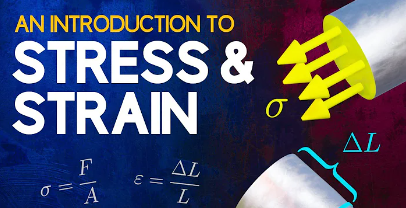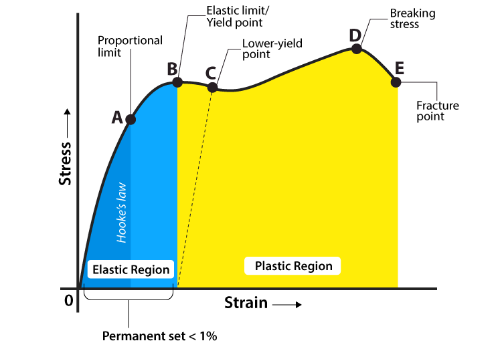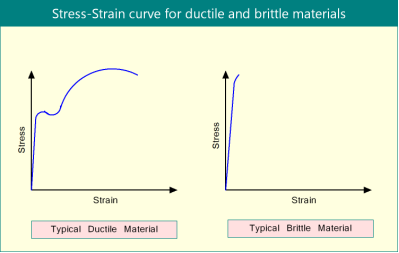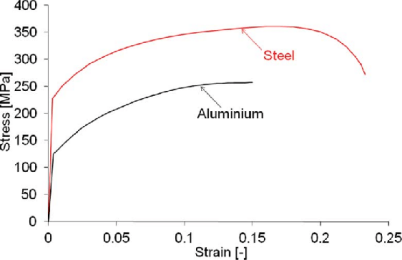Stress and Strain in Focus: Key Differences and Engineering
 Mar 13,2024
Mar 13,2024

Stress and strain are influential phenomena in engineering and technology. They give insight about the mechanical properties of a material. Stress develops when a pressure is applied on an object. This enables the deformation which is called strain. So basically, stress is the applied pressure and strain is its resultant deformation. However, their relationship in is not so simple. And it varies with the material depending on the material type, compositions, crystal structure and microstructure and the applied loading conditions. This article will help you understand the basic concepts of stress, strain, and their relationship. We will further discuss the nature of stress-strain, their origin, analysis, and measurement. And also, how they affect the material in terms of mechanical properties and the effects on its performances to predicts the material failure.

Introduction to Stress and Strain
Definition
Stress defines as the force acting on unit area which is applied on an object. This feature assists in defining the load bearing capacity of a material.
Strain defines as the deformation that occurs when an external pressure is applied. It shows how much a material is deformed when the stress is applied. It is the change in the length in material that occurs due to the applied force.
Units
The unit to represent the stress is Pascal (pa) while strain is the ratio of change in length to original length which is dimensionless ratio, so it has no unit. Sometime represents as deformation per unit length.
Nature
Stress is the measuring of applied pressure to material. And strain is the deformation which occurs by applying load.
Dependency
Stress is independent because it can occur in rigid material. But strain is the result of applied load.
Types
Stress has a few types. These are tensile, compression, and shear stresses. And strain also have corresponding such tensile strain etc.
Importance in Materials Science and Engineering
Stress has two important parameters which are notable in materials science and engineering. These are stress testing and stress analysis. Stress testing is the method of applying force to a material to see its reaction under different loading conditions. Stress analysis is the measuring the optimal strength and durability of a material. it is to check the load bearing capacity of a material. The main reason is to analyze the material’ strength for real-life applications which is important in many industries like construction where it is necessary to measure the load bearing capacity of a material under different applied forces without failure.
Strain helps in measuring and understanding the deformation by applying load. The data of stress and strain gives a result in a shape of curve. This is further utilized to calculate the different materials properties. These properties are elastic modulus, yield strength, tensile strength, shear stress and ultimate tensile strength and many more.
Engineering vs. True Stress and Strain
True stress defines as the load divided by the actual cross-sectional area. Engineering stress represents the load divided by the original cross-sectional area.
Ture strain defines as the ratio of instant deformation to the instant dimension. Engineering strain can be obtained by dividing change in length to original length.
Stress-Strain Relationship
Stress-strain relationship is important to know the material’s properties under the action of loads.
Explanation of the Stress-Strain Curve
Stress-strain relationship is normally in the form of graph. The graph shows force is increasing gradually and strain is produced as a result. The nature of curve is different for every material. The point from O-B represents the elastic region which is reversible when the stress is removed, and material is deformed temporarily. The straight line in the elastic region from point O-A is the only area where Hook’s law is obeyed. After point B-E, there is plastic region which is a permanent deformation of a material and is irreversible.

Key Points on the Curve: Understanding Elastic Limit, Yield Point, and Ultimate Strength Proportionality Limit
After point A, proportionality or Hook’s law not further be obeyed and thus called proportionality limit.
Elastic modulus
Area under the elastic region is called elastic modulus. It represents the stiffness of material and also refers as Young’s modulus.
Yield point.
The point B after the material starts deforming plastically and is irreversible is called yield point.
Yield strength.
It is the stress required for plastic deformation of material from 0.2 to 0.5%
Ultimate Tensile Strength (UTS)
UTS defines the maximum amount of stress an object can survive before being fractured. It is measured in Pounds per square inch (PSI)
Fracture point.
The maximum stress where a material fails in the stress-strain curve is called the fracture point. and the stress at this level is fracture strength.
What Are the Benefits of Stress?
The benefits of stress related to stress analysis are as:
- Structural designing: it has benefits in structural design and testing to define the maximum stress a material can withstand without being failed.
- Material selection: material selection becomes easy when the stress behavior is known in a particular application.
- Failure analysis: stress analysis can identify the cause of material failure to improve the material’s selection and performance.
- Quality control: quality control is an important step in manufacturing processes and stress analysis helps in ensuring the material’s performance.
- Safety measures: stress analysis can help in preventing material failure.
What Are the Benefits of Strain?
The benefits of strain analysis area:
- Design and structural optimization: strain behavior for different materials helps in determining the design structure to ensure that it is safe, durable and efficient.
- Quality control: identification of defects and flaws becomes easier in manufacturing processes when a material has undergone strain analysis.
- material selection and characterization: strain analysis eases the selection of material, their properties, and its characterization.
- failure analysis: strain behavior helps in identifying the maximum strain a material can withstand before failure.
Difference between Ductile and Brittle Materials
Ductile materials can stretch easily and show deformation under the action of load. While brittle ones cannot stretch and get fractured when load applied. So, the brittle materials are hard and non-stretchable. While ductile shows elongation and deformation without failing.

Detailed comparison between Plane Stress vs Plane Strain
Plane stress is the state of stress in which stress components differ along the x-plane, y-plane but it is zero in z-plane. Plane strain is the state of strain in which strain occurs in x and y-plane and has zero strain in z-plane.
Brittle Material Stress Strain Curve vs. ductile materials
The stress-strain curve for ductile materials has elastic and plastic region. The stress increases gradually after the yield point and shows permanent deformation.
Brittle material does not deform. Their graphs show linear curve to failure. Grey iron and glass are examples of brittle material.
Tensile Stress vs Compressive Stress in different materials
Tensile stress shows the increase in length of an object when the pressure is applied. Compressive stress is the decrease in length of an object when load is applied. Stress-strain data can help in analyzing elastic modulus that further identifies the stiffness.
Stress Strain Modulus and its variations in materials like Carbon Steel and Low Carbon Steel
Carbon steel and low carbon steel are examples of ductile materials. Stress-strain modulus in these materials is characterized by the yielding ability at normal temperatures. carbon steel shows a linear stress-strain relationship to a distinct yield point.
Measuring Stress and Strain
Tools and Techniques for Accurate Measurement
Stress and Strain measurements can be carried out by tensile tests. Tools used are strain gauges, extensometers and machine crosshead movement is used. Geometric Moire method and optical strain measurement are other strain measurement methods. Each method has its own pros and cons.
Understanding Young's Modulus in Material Science
Youngs modulus helps in determining the relative stiffness of a material in stress-strain plot. it is measured by the slope in the elastic region. It is the ratio of stress to the corresponding strain and has no unit.
Material Behavior under Stress and Strain
Material behavior can be understood completely under load, when considering stress and strain together. The stress-strain relationship describes the elastic modulus of a material, UTS, and other mechanical properties of a material.
Elastic and Plastic Deformation
Elastic deformation is reversible and temporary deformation, and it is removed when the load is removed.
Plastic deformation is irreversible and permanent deformation which remains in the material when the load is removed.
How Different Materials React
The main reaction of a material is analyzed by the stress-strain curve. Elastic and plastic regions are two common ways to identify the materials properties. furthermore, ductile and brittle material has different stress-strain curve. Ductile material shows deformation. While brittle breaks and failed without deformation.
Material Testing and Design
Stress-strain relationship of a material can be tested by applying static and dynamic loads by tensile tester. Tensile tester applied load and measure strain which is useful in material testing and design.
The Phenomenon of Strain Hardening
Strain hardening is the strain after the yield point in the stress-strain curve. With the increasing load, plastic deformation is produced. This makes the material hard and strong and eventually becomes difficult to deform.
How Ultimate Tensile Strength(UTS) is determined?
UTS is obtained by applying load in a tensile testing machine. The maximum load bearing capacity before failure of a material is the UTS of a material.
Stress Tensor and its role in material design.
Stress is not a vector quantity because it has both magnitude and direction and does not obey any vector addition law. It is instead a tensor quantity when follows coordinate transformation addition law. This means if a load is applied to a material, then stress can be measured from different directions and not just any one direction.
Applications in Engineering and Design
Stress-strain relationship of material helps in understanding the reliability, safety and durability of materials. It is important to know the how much maximum loads can be subjected to an object during working.
Real-world examples of Shear Stress
Paint and brushing are the common examples. Other examples are walking, running. When a vehicle starts/stops, seat surface experiences shear stress.
Case studies of Brittleness in materials
Cast iron and glass are the common brittle materials. The materials break rather than deform permanently under the action of load, shock or impact.
Aluminum Stress Strain Curve in engineering applications
The stress-strain curve obtained by uniaxial tensile testing shows almost show same behavior for all the metal including aluminum. The metal elongates till the elastic region and as the force increases it deforms plastically and eventually breaks. It helps in studying elastic modulus, tensile strength, shear strength and other mechanical features of aluminum.

Advanced Concepts in Materials Science
Poisson Ratio of Concrete and its applications
Poisson’s ratio of static concrete is from 0.15 to 0.25. for fresh concrete like fluid has 0.5 value. This implies that fresh concrete Poisson ratio should not exceed 0.5 for better applications.
Dynamic Mechanical Analysis and Stress Modelling
Dynamic mechanical analysis is used to analyze the extracted data from stress-strain curve of a viscoelastic material. it uses to measure phase angle and deformation.
Engineering Stress and Yield Stress in material testing
Engineering stress is the load divided by the original cross-sectional area. it is apparent in ductile material after yield point when the yield stress proportional to the force decreasing due to the fracture of material.
Advanced Topics: Calculation Methods
Step-by-step guide on How to Calculate Stress and Strain
Stress formula is:

Strain can be obtained by:

Non-linear Stress-Strain Relationships
Simple stress-strain relationship is called linear elastic behavior. Non-linear stress-strain relationship has no proportional relation of stress and strain. This means strain does not always occur when load applied.
Impact of Temperature and Other Environmental Factors
Temperature affects the stress-strain relationship because material expands or contracts when temperature changes and material cannot deform freely when temperature is changing. Other factors like chemical composition, manufacturing process and presence of defects and cracks affect the stress-strain relationship.
Conclusion
Stress-strain curve is a graph of a material’s response when a force applied. Stress is the load applying on unit area of an object. Strain is the ratio of change in length to the original length after applying force on an object. Stress and strain are correlated. Strain occurs when stress is applied. Stress and strain have different types. These are tensile stress/strain, shear stress/strain and compressive stress/strain. Stress-strain graph has elastic and plastic areas. The elastic region shows the temporary deformation of material and is reversible. In the plastic region, materials are permanently deformed. And it remains in that condition after the load is removed.
 Tel/WeChat:
Tel/WeChat:  Email:
Email: 
 Home
Home
 Case Hardening vs Through Hardening: Understanding the Differences in Steel Treatment
Case Hardening vs Through Hardening: Understanding the Differences in Steel Treatment 







